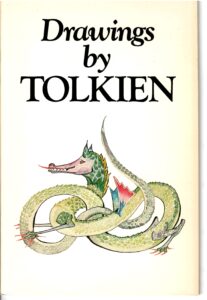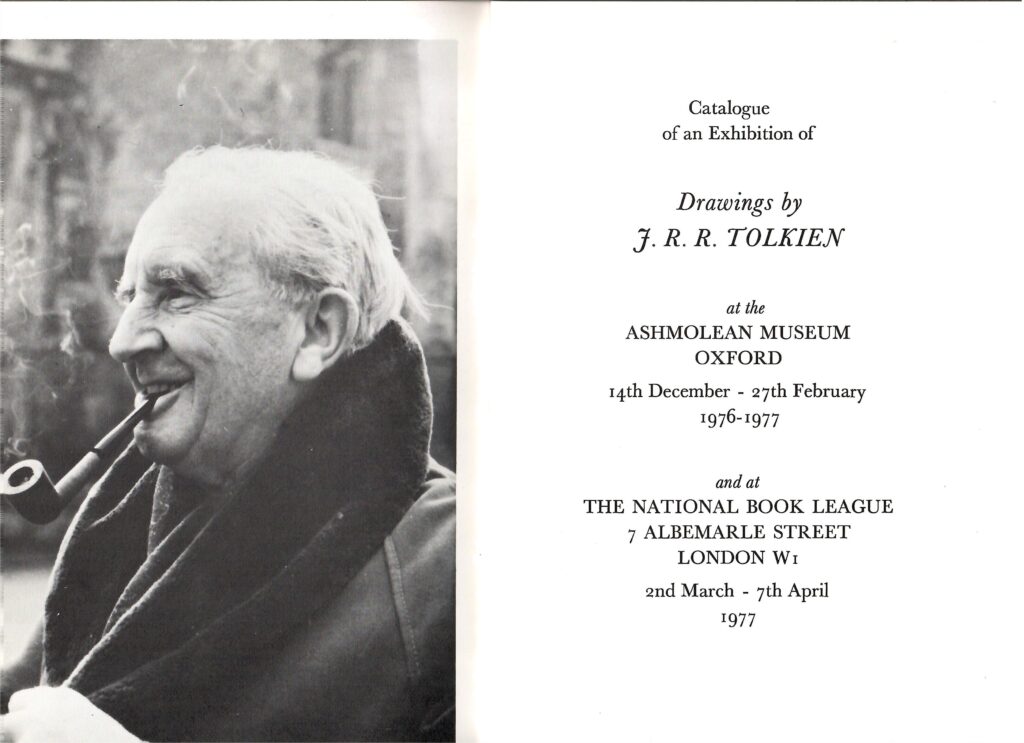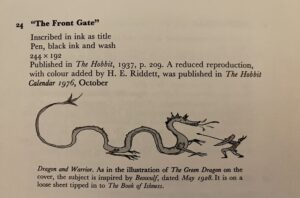I have been going through a number of small pamphlets and booklets in my Tolkien collection recently, and have been posting about them on Twitter:
- see here for a thread on the UK and USA Hobbit 50th Anniversart commemorative booklets
- and here for for the sale catalogue of Pauline Baynes’s drawings and sketches at Blackwell’s Rare Books in 2015 (which also includes Narnia material)
 I started another thread today, on another booklet, and then realized I would have to eliminate interesting details to make it fit. So here’s my fuller discussion of Drawings by Tolkien, the catalogue of an exhibition of drawings by J.R.R. Tolkien at the Ashmolean Museum, Oxford, 14th December-27th February, 1976-1977, and at the National Book League, 7 Albemarle Street, London W1, 2nd March-7th April, 1977.
I started another thread today, on another booklet, and then realized I would have to eliminate interesting details to make it fit. So here’s my fuller discussion of Drawings by Tolkien, the catalogue of an exhibition of drawings by J.R.R. Tolkien at the Ashmolean Museum, Oxford, 14th December-27th February, 1976-1977, and at the National Book League, 7 Albemarle Street, London W1, 2nd March-7th April, 1977.
My understanding is that this was the first bespoke exhibition of Tolkien’s art, and marked the first publication of The Father Christmas Letters, ed. by Baillie Tolkien (1976), later revised and enlarged as Letters from Father Christmas (1999). Drawings from these letters were displayed as part of this exhibition.

The exhibition catalogue booklet opens with a “Foreword” by Kenneth John Garlick (1916-2009), Art historian and Keeper of Western Art at the Ashmolean Museum, Oxford, from 1968 until 1984. He remarks that “few can be aware that [Tolkien] was a practicing draughtsman, and water-colourist” and calls this “an unfamiliar and unexpected side to Professor Tolkien’s creative mind” (not that unfamiliar nowadays, of course!) He also notes that the selection of the exhibition items and the compilation of the catalogue entries was done by the Countess of Caithness (1954-1994), who apparently worked as a volunteer at the Ashmolean at the time[i], and Mr Ian Lowe (1935 – 2012), at the time the Assistant Keeper of Western Art at the Ashmolean, aided by Christopher Tolkien. Apparently, the Countess and Mr Lowe also had sight of the – then – unpublished manuscript of Humphrey Carpenter’s biography of J.R.R. Tolkien, which, the Foreword remarks, “is hoped will be published in the spring of 1977” (J.R.R. Tolkien: A Biography was, indeed, published on 5 May 1977). Gratitude is expressed to both Christopher Tolkien and Humphrey Carpenter, but, Kenneth Garlick adds, both the Countess and Mr Lowe “recognize… that they are tyros in the field of Tolkien studies”. I am wondering, is this the first time the term “Tolkien studies”, as a field of academic research, was ever used?
The Foreword is followed by a short, but really fascinating, “Introduction” by Baillie Tolkien. In it she describes Tolkien’s art as “the product of a wholly private activity, ancillary to his writing” which was most likely never intended for publication or exhibition. She comments on Tolkien’s self-awareness of his limitations as an artist: for example he was perfectly aware that he wasn’t very good at drawing figures but she also argues that his drawings of Hobbits (sic) allowed other artists and illustrators to draw “extraordinary conclusions about their appearance”.
Baillie Tolkien also comments on Tolkien’s power to “render scenes visible with words alone”, which she describes as one of the great strengths of his writing, and goes on to protest that “is it all the more baffling that outrageously unapt pictorial material has often been published in connection with his books”, citing Tolkien’s own words upon seeing “an illustration by someone who had obviously not read the books”: “I sometimes think I am living in a madhouse’.
One wonders whether this type of comment refer to cases such as the infamous cover of the Ballantine edition of The Hobbit (showing a lion? and emus? really?) or other covers Tolkien had commented unfavourably on, such as the cover of the Swedish translation of The Lord of the Rings (1959).
Baillie Tolkien also makes some particularly apt remarks about Tolkien’s perception of beauty in his writings, as opposed to the colour palette in his art. She comments:
while beauty, in his writing, is almost always idealized, in terms of gold, or silver, or the bright glow of light from within (as exemplified most of all in the Silmarils), his painting nevertheless shows an exuberant use of bright and exotic colours, producing at times the effect of stained-glass windows, or the illuminations of medieval manuscripts.
She also singles out his artistry when drawing trees, a recurrent presence in his art, to which he manages to give “grace and character and individuality”.
Most importantly for what we now know came many many years after she wrote this Introduction, Baillie Tolkien notes that Tolkien’s drawings show “a deceptive combination of naturalism and formality”: naturalistic elements such as trees, rivers, etc. are brought together with “exotic” patterns, “not unlike tapestry”. One wonders whether the seeds of an idea were there already, not realized until many years later in the magnificent tapestries of Tolkien’s art at Aubusson.
Baillie Tolkien ends with a very discerning remark: reminding the reader that Tolkien may have disliked allegory, but insisting that he was “fascinated by symbols”. She argues that, from the beginning of his creative practice, Tolkien “explored the interrelationships of words, pictures, and symbols, inventing motifs, emblems, alphabets and scripts”, claiming that this is “the thread that connects everything he produced”. There is a lot to ponder about in this point, which links with the idea of naturalism and formality in Tolkien’s art (see above).
Baillie Tolkien’s Introduction is then followed by a brief “Biographical Note” by Humphrey Carpenter, a valiant attempt to summarise key points of his Tolkien biography, which was all but finished at that point, but not published yet. The only thing that made me stop and wonder in this “Biographical Note”, was this point by Carpenter:
This huge story [i.e. The Lord of the Rings], [is] truly a sequel to The Silmarillion rather than to The Hobbit.
In a way, I can see why Carpenter would say this: The Lord of the Rings isn’t a children’s book, with its more traditional “asides” and its simplification of the Middle-earth world (on which a lot of ink has been spilt!), but at the same time, this claim doesn’t quite work in terms of narrative threads (though, I guess, The Lord of the Rings does contain a summary of The Hobbit in its Prologue – I know I first read The Lord of the Rings without having read The Hobbit and had no problems following the plot). Still thinking about this, so leaving it here.
The catalogues booklet then moves to a traditional catalogue, explaining that the exhibition is arranged, “like Caesar’s Gaul” (!), into three parts: containing drawings associated with The Hobbit, The Father Christmas Letters, and The Lord of the Rings, respectively. There are no reproductions of images, bar a couple of monochrome details/scenes (see, for example, the “Dragon and Warrior” drawing below), but the catalogue describes the Hobbit illustrations as “bright and jewel-like”, singling out “Conversations with Smaug”.

The catalogue part on The Lord of the Rings makes an interesting comment on item 82, “Mt Doom”, later reproduced multiple times as “Barad-dûr: The Fortress of Sauron” (see relevant entry in Erik Mueller-Harder’s Tolkien Art Index: https://tai.tolkienists.org/tai/26/):
(82) is drawn on the back of a notice of a meeting of the Governors of the Schools of King Edward the Sixth in Birmingham dated 25 January 1939. Among the Governors was Professor L.P. Gamgee while the drawing shows Sam Gamgee’s path up Mount Doom.
Is the implication here that the name link prompted Tolkien to use this particular piece of paper to start this particular drawing? Another point to think about further.
The exhibition booklet, though on the surface pretty utilitarian, and not spectacularly illustrated like later catalogues of Tolkien exhibitions, was full of little surprises and discoveries for me – I’ve had fun exploring it in more detail and it’s given me a lot to think about further.
Endnote
[i] According to the obituary of Diana Caithness (née Diana Caroline Coke): “Soon after her marriage to Malcy Caithness in 1975, she worked as a volunteer in the Ashmolean Museum, dealing with the drawings by JRR Tolkien which had been placed on deposit by his son Christopher and the family’s trustees. The drawings, which were subsequently transferred to the Bodleian Library, had never been seen in public before. To Diana Caithness’s lot fell the work of ordering and listing the very extensive collection, preparing the formal receipt, and then organising the first exhibition (together with the catalogue), which was held in the Ashmolean from December 1976 until February 1977. It was a great success. The Father Christmas Letters, written to Tolkien’s children, were then published for the first time.” Diana Caithness took her own life in 1994.
